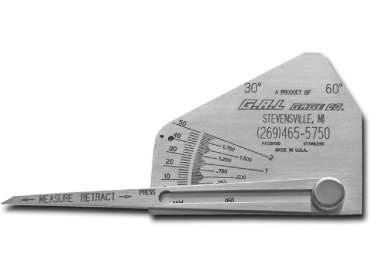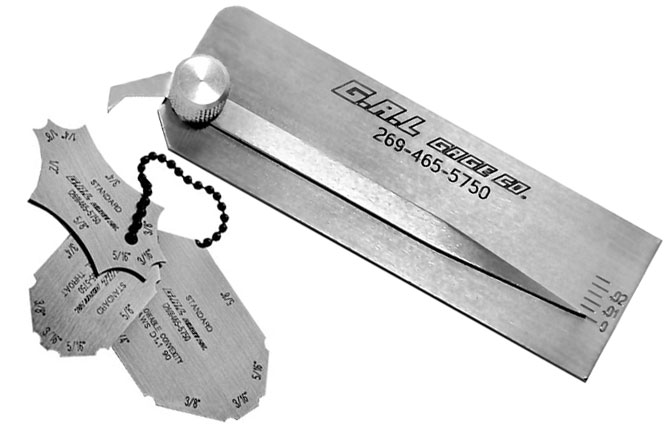The Function of Gauge Fillet Weld in Structural Integrity: What You Need to Know
The Function of Gauge Fillet Weld in Structural Integrity: What You Need to Know
Blog Article
Ingenious Approaches to Fillet Weld Evaluation and Testing: Enhancing Weld Quality and Conformity Requirements
In the realm of welding, the high quality and stability of fillet welds play an essential duty in making sure the structural stability and reliability of various commercial components. With the continuous drive for improved effectiveness and conformity with rigorous standards, the exploration of ingenious strategies to fillet weld evaluation and screening has ended up being important.
Advanced Non-Destructive Testing Approaches
Utilizing state-of-the-art innovations, advanced non-destructive screening approaches play an important function in making sure the stability and quality of fillet welds. These techniques, such as phased array ultrasonic testing (PAUT) and magnetic fragment testing (MPT), deal thorough insights into the weld's inner structure without creating any damages to the product. PAUT, for instance, uses several ultrasonic aspects to check the weld from numerous angles, providing a comprehensive visualization of potential issues like absence of blend or splits.
Likewise, MPT is effective in detecting surface-breaking problems by using a magnetic area and iron fragments to the weld area. This approach is particularly valuable for recognizing interruptions that may endanger the weld's strength. By utilizing these advanced non-destructive testing strategies, weld assessors can properly evaluate the quality of fillet welds, making certain compliance with market criteria and policies. The capability to detect imperfections at an early stage not only improves weld quality yet also protects against costly rework or failures in structural stability, underlining the relevance of these innovative screening methods in welding assessments.
Robotics and Automation in Examination

The combination of robotics and automation has revolutionized the inspection process for fillet welds, boosting performance and precision in high quality evaluation. Robotics supply precise control and repeatability in checking welds, making sure trusted and consistent outcomes. Automated systems can be programmed to adhere to certain examination paths, ensuring detailed protection of welds and minimizing the risk of human error.
Robot evaluation systems furnished with innovative sensors can spot and determine weld features with high accuracy, giving thorough data for analysis. These systems can identify issues such as splits, lack of combination, and porosity, making it possible for punctual rehabilitative activities to be taken. In addition, robotics and automation enable real-time information collection and analysis, providing instant feedback to drivers and facilitating quick decision-making processes.
Furthermore, the use of robotics and automation in fillet weld examination improves total performance by minimizing examination times and increasing evaluation throughput. By simplifying the evaluation process, manufacturers can ensure weld top quality and conformity standards are satisfied successfully, eventually causing cost savings and boosted product high quality.
Utilizing Expert System for Evaluation
Man-made intelligence plays a pivotal function in enhancing the performance and accuracy of evaluation in fillet weld assessment processes. AI algorithms can rapidly refine huge quantities of information from weld examinations, spotting issues or inconsistencies that may be testing to recognize with the nude eye.
Additionally, AI systems can pick up from previous assessment information, consistently improving their capacity to identify prospective issues and variances in fillet welds. This adaptive learning capacity boosts the total quality control process, minimizing the chance of human mistake and ensuring that welds meet the needed requirements. By integrating man-made knowledge right into fillet weld evaluation, industries can achieve greater levels of efficiency, uniformity, and compliance in their examination practices.
Portable Equipment for On-Site Evaluation
Enhancing field examination efficiency, the adoption of mobile tools reinvents on-site assessment procedures for fillet welds. These tools supply adaptability and ease, enabling examiners to carry out complete evaluations in numerous areas, consisting of tough or remote atmospheres. Mobile tools such as ultrasonic screening gadgets, magnetic fragment inspection tools, and digital radiography systems provide real-time information and high-resolution imaging abilities, enabling fast decision-making and prompt comments on weld quality.
One considerable advantage of check out this site portable devices is their capacity to improve inspection treatments, reducing downtime and enhancing general efficiency - Gauge Fillet Weld. Assessors can easily transport these tools to different job websites, eliminating the demand for carrying heavy machinery or components to off-site facilities. Additionally, the portability of these devices promotes cost-effectiveness by lessening transport expenditures and speeding up examination timelines
In addition, the usage of mobile devices for he has a good point on-site examination advertises proactive quality assurance measures, as examiners can promptly recognize and resolve any possible welding defects or inconsistencies. By integrating these cutting-edge technologies right into on-site assessment methods, welding experts can make sure compliance with industry criteria and improve weld high quality, inevitably bring about boosted structural stability and safety and security in various welding applications.
Combination of Information Management Equipment

Having actually enhanced on-site examination processes through the application of portable tools, the next stage entails the seamless assimilation of data administration systems to better enhance performance and information evaluation abilities in fillet weld evaluation and testing. By integrating data administration systems into the assessment procedure, companies can simplify information collection, storage, and analysis. This combination permits real-time surveillance of weld top quality, instant recognition of flaws, and prompt decision-making to correct any concerns that might emerge during the inspection process.
The assimilation of information management systems allows seamless interaction in between different stakeholders involved in the examination procedure, cultivating collaboration and improving general top quality control measures. Ultimately, the combination of information monitoring systems serves to elevate the standards of fillet weld examination and screening, ensuring compliance with market laws and improving weld quality.
Conclusion
To conclude, ingenious methods to fillet weld inspection and testing have dramatically boosted weld high quality and compliance standards. Advanced non-destructive testing methods, robotics, automation, expert system, portable tools, and information administration systems have reinvented the means weld inspections are conducted. By utilizing these innovations, markets can ensure that welds meet the called for quality requirements and regulations, eventually enhancing general performance and safety and security in welding processes.

Having actually enhanced on-site examination procedures via the use of mobile devices, the next stage involves the seamless assimilation of information management systems to additionally boost performance and information analysis abilities in fillet weld examination and testing. Inevitably, the combination of data management systems offers to raise the criteria of fillet weld assessment and screening, ensuring conformity with market laws and boosting weld top quality.

Report this page